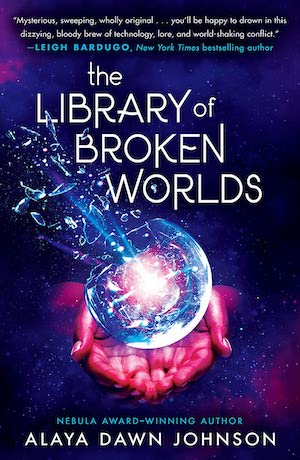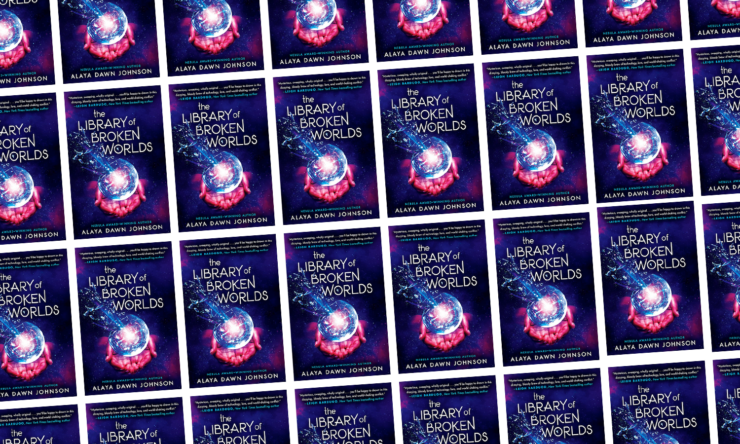In decades of reading SFF, I have never come across a world like the Library in Alaya Dawn Johnson’s The Library of Broken Worlds. Some things about it are familiar, though it would be rude to reveal the most important of those aspects. But most of it has sprung from Johnson’s head like Athena from the head of Zeus, and I am making this godly comparison on purpose, because the library is full of gods.
But these gods—material gods—are not like the names we know from ancient myths. They have avatars, personalities; librarians can commune with them in various ways that are not metaphors. The librarians do not use space Google (did I mention the Library is in space?), though they do have some basic querying tools. Instead, they delve physically into the library, mentally connecting to the gods, asking for the answers to massively important questions. One of those involves whether a culture can claim to have a right to murder others.
And many of those questions involve a girl named Freida, who was born in the library, and who, at the start of Johnson’s lush, layered, and powerful book, is on a mission to kill the oldest and bloodthirstiest material god.
First, though, they have a conversation.
It is no exaggeration to say I’ve been waiting for this book for at least nine years. Not this book, exactly—but a new YA book from Johnson, whose 2013 The Summer Prince, despite being longlisted for a National Book Award, seems to remain under far too many people’s radar. (Her latest adult novel, Trouble the Saints, won the 2021 World Fantasy Award.) The Summer Prince’s post-apocalyptic future, which takes place in an unforgettably imaginative setting, is full of art and love and death, cultures and clashes and nuance.
These things and more drive the story of The Library of Broken Worlds, which is the kind of book that begs for both a deep spoilery assessment that teases out the many threads woven into its bright cloth, and to be read without expectations. (Since it’s just out, I will avoid spoilers.) In a way I can’t quite put my finger on, Broken Worlds feels like a YA cousin to Simon Jimenez’s The Spear Cuts Through Water; there aren’t quite as many storytelling forms, but there are so many layers of myth, and lies, and family, all built into a story that challenges you to separate the personal from the political from the spiritual from the practical.
Buy the Book


The Library of Broken Worlds
What if there are gods, but there are also tesseracts? (More L’Engle than Marvel, these, but also entirely their own thing.) What if humanity exists in space but humanity’s worst tendencies—toward domination and power-grabs—just come with us, even as other planets, other worlds, come into the mix? What is an AI, anyway? (I really don’t mean the chatbot kind.) What is a destiny? What is love, and family, and how do people build their own families or separate from the ones that hurt them?
The Library of Broken Worlds is the story Freida tells the Nameren, the god she needs to destroy. But she is also being destroyed, ravaged by a virus in her body as she communes with the bull-god of the Mahām, a dominating world with a small moon full of dissidents called the Miuri. On another side of the galaxy is the world of the Awilu, described by one character as “the peacekeepers, the old ones, the creators of the gods themselves.” The system that is home to Tierra, Mars, Sol, and Luna makes another point of a triangle. The Library sits in the middle and keeps the peace. Tesseracts allow for instantaneous travel between worlds, though each tesseract is controlled by only one of the worlds it touches.
Freida, who was found in the Library tunnels as a baby, is a source of some controversy among the Librarians, in whose ranks she would like to belong. Is she a person? Is she a program? Is she made by the gods? What is she, exactly? Nadi, the Head Librarian, found her and treats her like their child; Quinn, who has designs on Nadi’s position, treats her like a thing.
And Freida has extra reason to mistrust Quinn, whose nephew assaults her early in her story. This happens in a “nanodrop,” a sort of virtual reality experience, and Freida doesn’t know what to make of it, how to describe or categorize it. Was it real, if it only happened in her head? Does it matter, when it feels real? She keeps this to herself, hiding it even from Nadi, and the trauma settles deep in her bones as she grows and learns and inches toward a first love, and then a second.
The story that Freida tells the Nameren is about those she loves, and about how she helped, or tried to help, both of her beloveds find solutions to problems that are truly life or death. Joshua, who comes from Tierra, is trying to win a complex legal argument about his people’s right to their homeland. (An author’s note specifies that Johnson is not representing any “modern human cultures, beliefs, or conflicts,” but, as she writes, “the exploitation of the powerless by the powerful is sadly a perennial theme in human history.”)
Freida’s other, more reluctant beloved is the fantastically stubborn Nergüi, a refugee and Disciple of the Lighted Path. She carries a ball of lights that reminds me, distantly, of Eilonwy’s glowing sphere in Lloyd Alexander’s Prydain, but it’s so much more, including a symbol of a way of viewing life and the worlds that is heretical to the Mahām. Nergüi searches for a specific story type that will ring bells for my fellow fans of Spirited Away, and she is trying to work through the library to save her people from the War Ritual. The proponents of said ritual say it is a cultural activity. But when one people murders another, it looks like war, ritual or no.
The three of them are young, ambitious, troubled, and in the great tradition of YA protagonists, they have so much to learn—about how their worlds are not necessarily the places they believe or want them to be, and about how there is always, always more to discover about the world, or worlds, or gods, or yourself, and what you’re capable of. At the heart of their stories is the idea of freedom from and freedom to, and how these concepts must work together. If one group’s freedom to stomps all over another’s freedom from, is anyone free?
Open The Library of Broken Worlds to just about any page and you will find rich storytelling that ranges from the practical (every food detail is a delight) to the explosive, from the intimate details of Freida’s life to the story of how her world came to be. Johnson layers myths on histories on gods on planets, and it feels as if there’s enough world—or worlds—here to sustain countless more tales. But this one alone is a feast, artful, imaginative, and unmatched.
The Library of Broken Worlds is published by Scholastic.
Molly Templeton lives and writes in Oregon, and spends as much time as possible in the woods. Sometimes she talks about books on Twitter.










